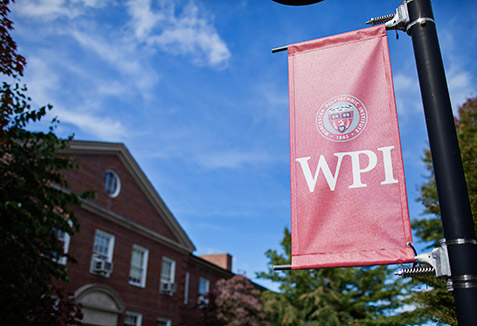Great Problems Seminar Courses Incorporating AI
One of the AI-focused Great Problems Seminar courses is AI, Design, and Society. In it, students are exploring what it means to be human in a digital world by studying the history of artificial intelligence, building and using AI systems, imagining a future with or without AI, and designing interactive experiences that explore the role of AI in our daily lives.
In the first term of the course, students made and programmed their own AI generators, which use artificial intelligence and prompts to create digital images or text.
“We’re getting a general sense in this course of how AI works,” said Alex Hardro ’28, a computer science and interactive media and game development double major. “I think one benefit is efficiency. AI can sort through so much information, and you can program it to look at problems in different ways to come up with solutions.”
Hardro said the class has made him think about the challenges associated with AI, including biases that reflect the human-generated information that feeds AI. He also said the class has given him the opportunity to critique AI generators. He said in many cases the images AI generators create are unrealistic and inaccurate. “When AI was asked to generate a face, the proportions were off,” he said. “It was not very good at accomplishing this task.”
In December, students in AI, Design, and Society pitched proposals for group projects to explore potential AI solutions to societal challenges.
In the course’s second term, which began in mid-January, students are working on group projects to design and explore the societal implications, positive and negative, of potential AI solutions in roughly a dozen areas including energy consumption, unequal access to food, disease detection, and language education.
“This might be the first time some of these new students are getting guidance on the appropriate use of AI in classroom and research settings,” said Gillian Smith, director of WPI’s Interactive Media and Game Development program and associate professor of computer science, who teaches the course with Stanlick. “I think this approach is helping students learn how to use AI tools and to understand that AI is not just an insular app. It has a broader ecosystem with environmental impacts.”
The other Great Problems Seminar course that integrated AI was Smart and Sustainable Cities, which concluded in December. In the class, students explored how artificial intelligence is incorporated into smart city tools such as sensors used for resource management and law enforcement. They explored how these tools reflect the history of race, class, and gender and were asked to consider their own values as society confronts technological disruptions.
“There’s a long history of thinking technology will solve all of society’s problems,” said Katherine Foo, assistant professor of teaching in the Department of Integrative and Global Studies, who co-taught the course with Stephen McCauley, associate professor of teaching in the Department of Integrative and Global Studies. “This course helps students develop their critical thinking about the economic, political, and social impacts of technology,” Foo said. “I think understanding these impacts will enable technologists to not only make technical innovations, but strategic social innovations as well.”
In this class, students worked in teams to explore the opportunities, risks, and challenges of implementing technological solutions to societal challenges including fossil fuel dependence, road safety, and urban heat islands.
In December, students in Smart and Sustainable Cities presented their findings from projects that explored the opportunities and challenges of implementing technological solutions to societal challenges.
“I’m curious about whether AI will be used to connect communities or if it’s just going to be used as a technical tool,” said Anna Towne ’28, a computer science major. “We learned a lot in this course about the difference between technical innovations and social innovations. It feels like AI is a strong technical innovation, but I wonder if it will ever be a social innovation.”
Victoria Zamora ’28, another computer science major, said the course helped her understand the need to consider the potential impact of social inequities when technical solutions are proposed and discussed in communities. “It’s helpful that, as first-year students, before we even really truly embark on our journey in our various fields, we’re given this opportunity to really think about the consequences of our innovations,” she said. “Yes, technology may yield certain benefits, but there’s still more to think about.”
To help achieve a deeper understanding, students were guided to use generative AI tools to assist with their projects and were asked to reflect upon the tools’ benefits and limitations in those scenarios. In one assignment, students used AI tools to generate images to help visualize proposed design changes and for potential use in their poster presentations. In another, students prompted a chatbot to present the views of stakeholders in a city on an issue to assess whether it could simulate field work. In general, students reported AI as being helpful for brainstorming but said that it was challenging to vet the accuracy of information generated by AI.





